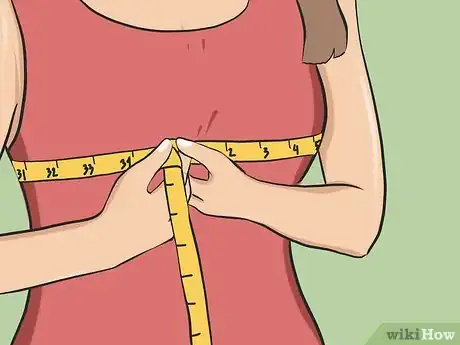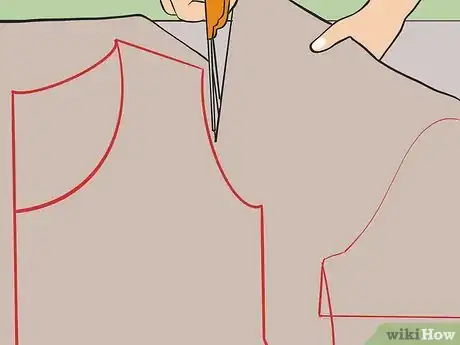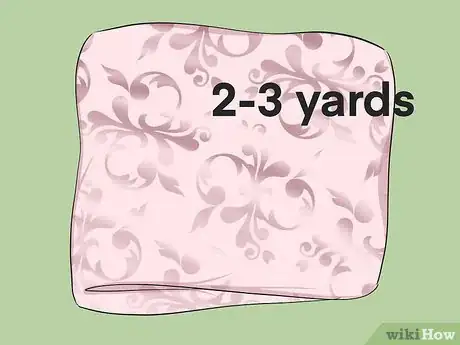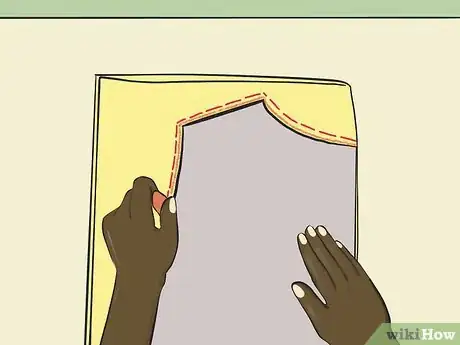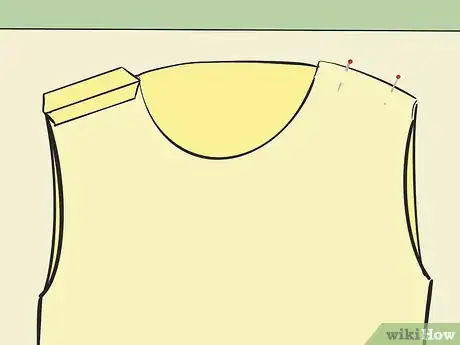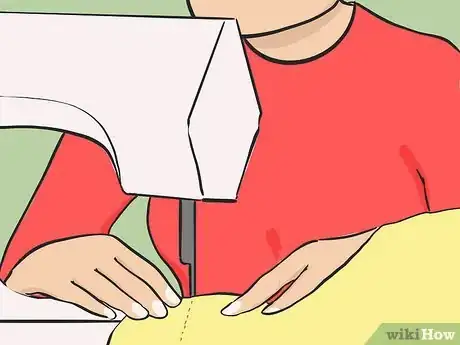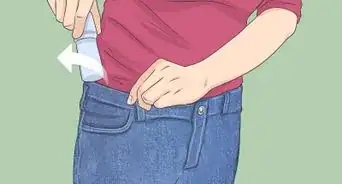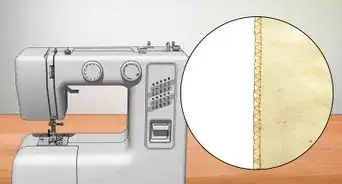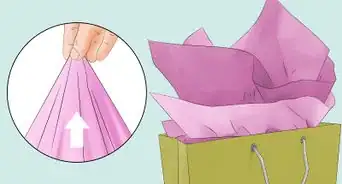This article was co-authored by Connie Tao. Connie Tao is a Bridal Designer and the Founder of Connie Tao Designs in Pasadena, California. Connie has over 12 years of experience and specializes in creating handmade custom wedding dresses and evening gowns. She and her team also do alterations and redesigns to existing garments. Connie received her Bachelors Degree in Fashion Design from Otis College of Art and Design.
There are 15 references cited in this article, which can be found at the bottom of the page.
This article has been viewed 23,722 times.
A tunic is a long, loose fitting top that fully covers the hips and bottom. Making your very own tunic can be a fun task, and you’ll be able to show your creative side with your choice of colors, length, and detailing. To do this, you’ll need to decide on a pattern, pick a fabric, and then master the sewing. Then you’ll be ready to show off your unique tunic to everyone!
Steps
Creating a Tunic Pattern
-
1Choose your tunic style. Consider what type of tunic you would like to wear before deciding on a pattern. Choose your sleeve, length, neckline, and waistline. Research different tunic styles online and find one you like. You can even sketch some ideas on paper if you want to create something original. Once you know what style of tunic you want to make, you can choose a pattern and the best fabric.[1]
- Some popular styles are the “T” tunic, medieval, baby doll, and dolman tunic.
- If you’re a beginner to sewing, choose a sleeveless tunic. That way, you don’t have to worry about sewing perfect sleeves.
-
2Find a pre-made tunic pattern that matches your style. If you don’t want to go through the hassle of creating your own sewing pattern, you can easily find one online or purchase one at a fabric or craft store. If you’re new to sewing or creating clothing, make sure the pattern is easy for you to follow. You can use more complicated patterns as you practice and gain experience.Advertisement
-
3Use your own clothing to create a pattern. If you already own a tunic that you love and fits you well, you can use it to replicate and make your own pattern. To do this, you’ll need to trace each section of the tunic on large paper. A simple tunic will have just two parts; the front and the back. If you want to add sleeves, you’ll need to trace those too.[2]
- While tracing, use push pins to hold the garment in place.
- Make sure you label each drawing so later on you’ll remember where each piece goes.
-
4Create a custom pattern using your own body measurements. If you don’t already have a tunic, and you feel confident in your measuring skills, you can create your own pattern from scratch. Use a measuring tape to measure the fullest part around your bust, true waist, and hips. Then measure the length of your back (from the neck to the waistline), the width of the chest, width of the back, and distance from the neck to the shoulder bone. Then use these measurements to draw the pattern on a large piece of paper.[3]
- Make sure you are standing nice and straight while taking these measurements.
- If your tunic is going to have sleeves, measure around the fullest part of your upper arm.
-
5Cut out your pattern. Use a pair of scissors to cut out all of the pieces that make up your tunic pattern. This should include the front, back, and sleeves if there are any. Work carefully to make sure you cut on the lines. Try your best to avoid folding or wrinkling the paper.[4]
- If the paper has wrinkling or creases, carefully dry iron the paper on low heat to make it smooth.
Cutting the Fabric Pieces
-
1Choose your fabric. Tunics are very versatile and can be any fabric you like. Consider the climate and style of your tunic. For example, if you plan on wearing your tunic in the summer time, pick a fabric that’s light and airy, such as linen or chiffon. Choose a thicker fabric in cooler temperatures, like flannel or wool.[5]
- Some thin fabrics are more difficult to manipulate and sew. So if you’re a beginner, consider choosing a thicker fabric, such as knit or double gauze.
- Use your pattern as a guide to picking the right fabric. For example, avoid denim if you want a tunic that drapes or stretches because this material is very heavyweight. Instead, choose knit or silk.
-
2Obtain 2-3 yards of your chosen fabric. Make sure you get enough fabric so you’re not running back and forth to the fabric store. The rule is to determine the length of your tunic, and then get double that length of fabric plus an extra 1⁄4 metre (0.27 yd).[6]
- For a knee length tunic, it is recommended to purchase 2.25 yards (2.06 m) of fabric. Of course, the amount of yardage will depend on your height and weight.
- Follow the manufacturer’s instructions on whether or not to wash the fabric before sewing. You’ll need to pre-wash certain fabrics, such as flannel, to prevent shrinkage once your tunic is finished.[7]
-
3Fold your fabric in half lengthwise and place the pattern pieces on top. If you purchased a pattern or found one online, follow instructions for positioning and cutting the fabric. Fold your fabric in half before placing the pattern pieces on top. Folding the fabric in half will give you the front and back of the tunic.[8]
- To keep the pattern pieces in place, use sewing pins or pattern weights. These items can be found at a fabric or craft store.
- Remember to work on a flat surface and to lay down your fabric flat and smooth before laying the pattern on top of it.
-
4Trace the outline of the tunic pattern pieces on the fabric with a marking tool. Once you have properly positioned your pattern pieces on top of your fabric, trace the outline with your marking tool of choice. You can use tailor’s chalk, a marking pen, or even bar soap. This will help you to cut your fabric straight and precise.[9]
- There are pros and cons to each type of marking tool. For example, tailor’s chalk is very easy to use, but it can fade very quickly with the slightest touch. Choose the marking tool that you believe will do the best job for your garment.
-
5Use fabric scissors to cut the fabric. Now that you’ve accurately marked the outline of your pattern pieces on the fabric, grab a pair of sharp fabric scissors and cut out the pieces. Cut with one hand holding the scissors and the other hand holding the fabric. Cut it as accurately as possible to ensure your fabric pieces match the pattern.[10]
- Make sure your fabric scissors are as sharp as possible. Dull scissors may snag your fabric.
- Use a rotary cutter for thicker fabrics, such as leather. This tool is not necessary but will make cutting easier.
Sewing the Tunic
-
1Line up the bodice pieces and pin them together. Take the two pieces that make up the front and back of the tunic, put them together with the fronts of the fabric facing inward. This is how you’re going to sew them, so when you turn it inside out the seams aren’t showing. Position the pieces so they are perfectly lined up, then use sewing needles along the edges to pin them together. Pin all around the bodice perpendicular to the edge everywhere you’re going to sew (the shoulders and sides).[11]
- Use as many needles as you can so the two pieces stay put together.
-
2Sew the shoulder seams. If you’re confident with your ability to hand sew a straight line, you can use a needle and thread. You can also use a sewing machine for this step and each subsequent step. Take your two bodice fabrics and sew a seam along the shoulder line to join them together.[12]
- Do a lapped seam for heavy fabrics like leather or suede. Try a French seam for thin or sheer fabrics.[13]
- If you purchased your pattern or found it online, follow the instructions to see if there is a seam allowance. In many cases it’s 5⁄8 inch (1.6 cm).
-
3Sew the side seams of the tunic. Once you have sewn both shoulder seams, sew along the side of the tunic using the sewing machine or by hand sewing. Repeat on the other side of the garment, and sew all the way to the end. Remember to use the seam allowance provided by your tunic pattern.[14]
- Make sure you leave holes for the arms and the bottom. You don’t want to sew those up!
-
4Fold the bottom fabric of the tunic to make a hem. Use a seam ruler to determine how long you want your hem to be. Tunics should have a hem that’s at least 1.5 inches (3.8 cm) long. Fold the fabric at the exact spot you’ve chosen. Iron the fold to press it so it stays down when you’re ready to sew it. Then, pin the hem in place.[15]
-
5Sew the hem using a simple stitch. Take your tunic over to the sewing machine and sew in a straight line around the edge of your tunic near your pins. A simple stitch is typical for tunics. If you’re sewing by hand, try a catch stitch.[16]
-
6Clip away any excess thread for a clean finish. Once you have finished sewing your tunic, clean up the extra thread by using fabric scissors to cut it off. When using the sewing machine, you might have noticed some extra thread hanging off the seams. You need to cut that fabric off to prevent your finished tunic from looking raggedy.[17]
- Be careful not to cut off any fabric from your tunic when clipping excess thread.
Things You’ll Need
- Tunic pattern
- Fabric of your choice
- Pencil
- Fabric scissors
- Fabric marking tool (tailor’s chalk, marking pen, tacks, bar soap, stitches)
- Sewing pins
- Sewing machine
- Spool of thread
- Seam ruler
References
- ↑ https://stylesatlife.com/articles/tunics-for-women/
- ↑ https://youtu.be/vgh7EHTnQPk?t=101
- ↑ https://youtu.be/EmLThmehn7M?t=28
- ↑ https://www.womansweekly.com/sewing/how-to-make-a-dress-how-to-cut-fabric-with-a-paper-pattern-19094/
- ↑ https://www.mybluprint.com/article/perfect-picks-choosing-fabric-for-clothes
- ↑ https://sewguide.com/how-much-fabric-do-you-need/
- ↑ https://www.mybluprint.com/article/how-to-wash-fabric-before-sewing
- ↑ https://www.womansweekly.com/sewing/how-to-make-a-dress-how-to-cut-fabric-with-a-paper-pattern-19094/
- ↑ http://sewguide.com/stitching-patterns/
- ↑ https://sewguide.com/cut-fabric-sewing/#what_are_the_essential_tools_you_need_for_cutting_the_fabric
- ↑ https://www.mybluprint.com/article/yes-you-can-sew-a-dress
- ↑ https://www.mybluprint.com/article/yes-you-can-sew-a-dress
- ↑ https://sewguide.com/how-to-sew-seams/
- ↑ https://youtu.be/mVk618EVF0Y?t=545
- ↑ https://www.sewing.org/files/guidelines/11_130_simple_hems.pdf
- ↑ https://youtu.be/OFyuv-P1f0Q?t=160
- ↑ https://youtu.be/mVk618EVF0Y?t=625



